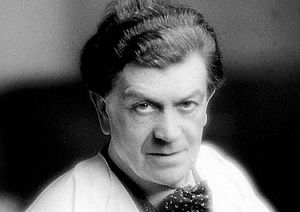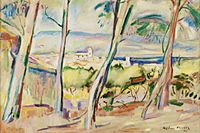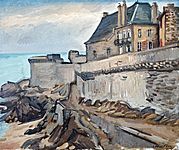Othon Friesz facts for kids
Quick facts for kids
Othon Friesz
|
|
|---|---|

Photograph from c. 1930
|
|
| Born | 6 February 1879 |
| Died | 10 January 1949 (aged 69) |
| Nationality | French |
| Known for | Painter |
| Movement | Post-Impressionism; Fauvism |
Achille-Émile Othon Friesz (born February 6, 1879 – died January 10, 1949) was a French artist. He was known as Othon Friesz. He came from Le Havre and was part of the Fauvist art movement.
Contents
Who Was Othon Friesz?
Othon Friesz was born in Le Havre, a city in France. His family had a long history of being shipbuilders and sea captains. He went to school in his hometown.
Early Life and Education
While at the Lycée (a type of high school), Othon Friesz met Raoul Dufy. They became lifelong friends. In 1895-96, both Friesz and Dufy studied at the Le Havre School of Fine Arts.
After their studies in Le Havre, they moved to Paris to continue learning art. In Paris, Friesz met other famous artists like Henri Matisse, Albert Marquet, and Georges Rouault.
Joining the Fauves
Like his new friends, Friesz did not agree with the traditional art teaching of Léon Bonnat. Instead, he joined a group of artists called the Fauves. The word "Fauves" means "wild beasts" in French. This name came from their use of bright, bold colors and strong brushstrokes.
Friesz showed his art with the Fauves in 1907. Their style was very new and exciting for the time.
A Change in Style
In 1908, Friesz went back to Normandy. He began to paint in a much more traditional way. He realized that his personal art goals were connected to older styles of painting.
He opened his own art studio in 1912. He taught art there until 1914. At that time, he joined the army for World War I.
Later Years and Legacy
After the war, Friesz returned to Paris in 1919. He lived there until he passed away in 1949. He made short trips to Toulon and the Jura Mountains.
For the last 30 years of his life, Friesz painted very differently from his early Fauve days. He stopped using bright colors and lively lines. Instead, he went back to a more serious style. This style was similar to what he learned from his teacher Charles Lhuillier in Le Havre.
He admired old masters like Poussin, Chardin, and Corot. Friesz painted in a way that followed the ideas of Paul Cézanne. Cézanne believed in clear composition, simple colors, solid shapes, and separate layers in paintings.
Friesz's most famous works include landscapes, still lifes (paintings of objects), and paintings of people. He died in Paris and is buried in the Cimetière du Montparnasse. Some of his students included painters Marthe Rakine and Heini Waser.
Paintings by Othon Friesz
-
Roofs and Cathedral in Rouen, 1908. This painting is at the Hermitage Museum.
-
Les remparts de Saint-Malo (The Walls of Saint-Malo), 1935. This painting is at the Musée Toulouse-Lautrec in Albi.
See also

- In Spanish: Othon Friesz para niños




